Real Madrid began the new season against Atalanta in the UEFA Super Cup with a 2-0 victory on a joyous night for their fans, marked by Kylian Mbappé scoring his first goal for Real Madrid.
That happiness did not last long, as Real Madrid drew in two of their first three league matches, thus dropping four points out of the initial nine available.
Los Blancos conceded their first goal in the new season, a Mallorca corner kick, which resulted in an equaliser.
We believe this goal serves as a wake-up call, signalling a persistent vulnerability that has carried over from the previous season.
Although this weakness is simple and apparent, it has only been exploited by a few teams.
Consequently, Carlo Ancelotti‘s side was the second-lowest team in La Liga for goals conceded from corner kicks last season, having allowed only two goals, with only Barcelona conceding fewer, who allowed just one goal.
In this tactical analysis, we will discuss Real Madrid’s tactics in defending corners and its most significant weaknesses, showing how a few teams have attempted to exploit them.
We will also provide suggestions for addressing these issues and improving defensive performance.
Real Madrid Tactics – The Far Post Issue
Starting with their main defence scheme, they assign six zonal defenders.
Five are aligned to the goalmouth, while the sixth, usually Dani Carvajal, is responsible for getting the first touch in the area before the near post.
Above them, they put three blockers around the penalty spot whose job is just to block and slow down three of the opponents’ runners to reach the zonal line without a dynamic mismatch.
One of them is rarely assigned to mark a certain player in case of coming up against a strong player in aerial duels.
After that, they assign a player on the edge of the box to get the second ball and counterattack after that.
They usually ask the last zonal defender — Jude Bellingham, in this case — to stand deeper inside the six-yard line, as shown below.
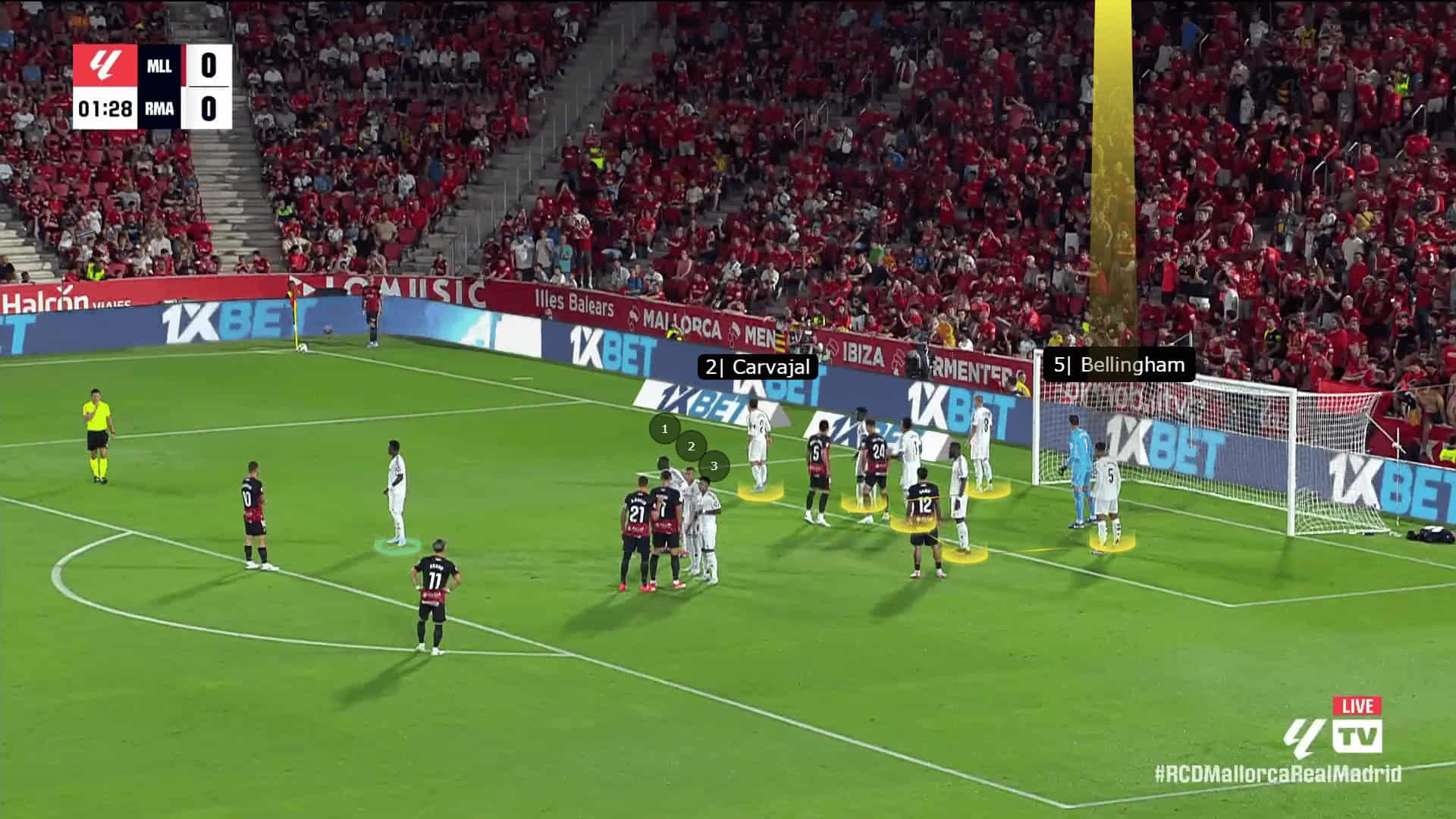
In the photo below, it is clear that the zonal line gets a bit inclined to the outside while also asking Bellingham to stand a bit inside.
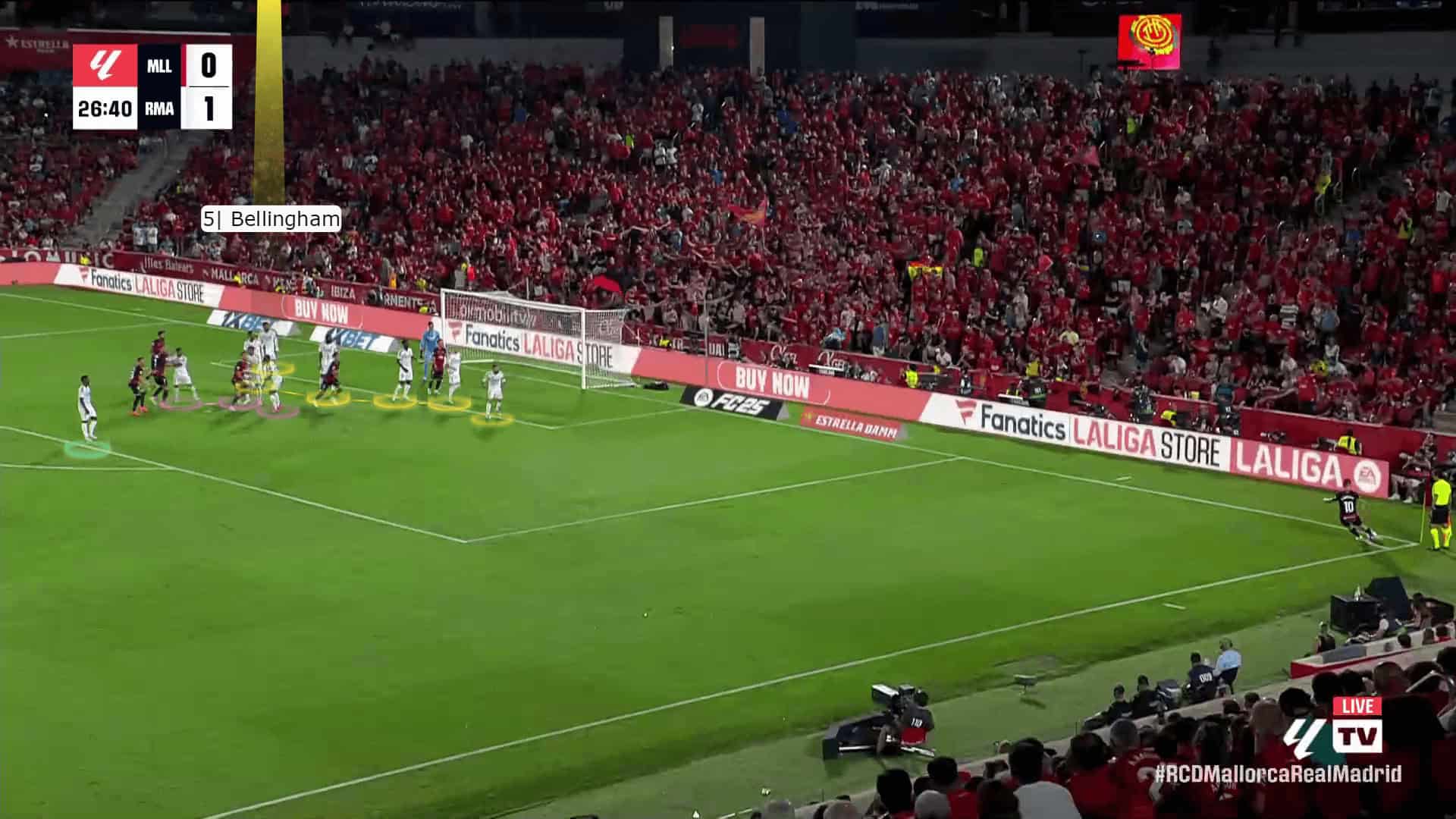
In the UEFA Champions League final against Borussia Dortmund, Toni Kross, in this case, it is clear below that the last zonal defender sometimes stands even more and more inside.
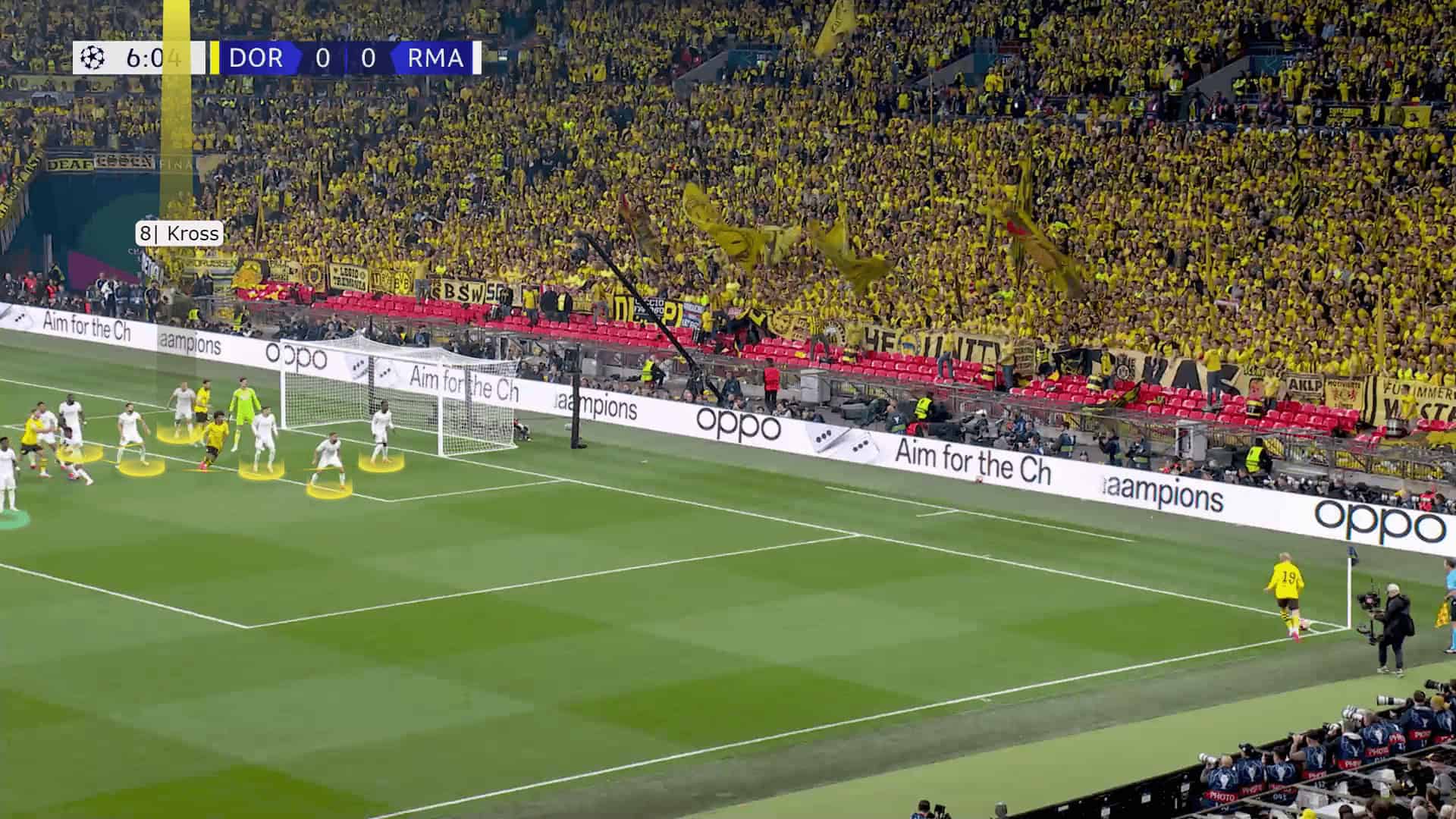
Regarding the far-post issue, we want to highlight four points that we are going to explain in detail:
- The last zonal defender, naturally, has the least aerial-duel ability of the members guarding the six-yard line.
- The issue of shifting toward the near post.
- The starting position of the last zonal defender may cause him to suffer from a dynamic mismatch.
- The blockers are too weak or don’t care about physical and aerial conflicts.
In the first case below, we will elaborate on the first two points while explaining the other two in the second case.
Bayern Munich were one of the few teams that tried to exploit this gap, but they were unlucky in the two semi-final matches of the UEFA Champions League.
In the photo below, Real Madrid’s usual scheme is clear: six zonal defenders, three numbered blockers, and Vinícius Júnior on the edge of the box.
The individuals are important here, so let’s mention the names of the zonal line in order from the near post side: Dani Carvajal, Federico Valverde, Eduardo Camavinga or Aurélien Tchouaméni, Antonio Rüdiger, Nacho or Éder Militão now and Jude Bellingham while Rüdiger may switch with Rüdiger depending on the side of most predicted danger, the near or the far post.
The blockers are Ferland Mendy, Brahim Díaz and Luka Modrić, who may be replaced with Rodryge and Kylian Mbappé, depending on the starting XI.
So, Real Madrid’s worst zonal player at aerial duels is usually assigned to the far post; they used Toni Kross in that role, and now they assign Bellingham or Fran García.
Hence, we know that the last zonal defender has the least aerial-duel ability of the members guarding the six-yard line and the most potential weakness.
Disclaimer: We know that Bellingham, in particular, isn’t bad at aerial duels and is quite a tall player who scores many goals with heading, but he is the least effective zonal player guarding the six-yard line, especially defensively, which needs more aggression and measurement of the ball in the air and jumping from a steady state.
The problem isn’t only the player themselves, so we come to the next problem, which is shifting.
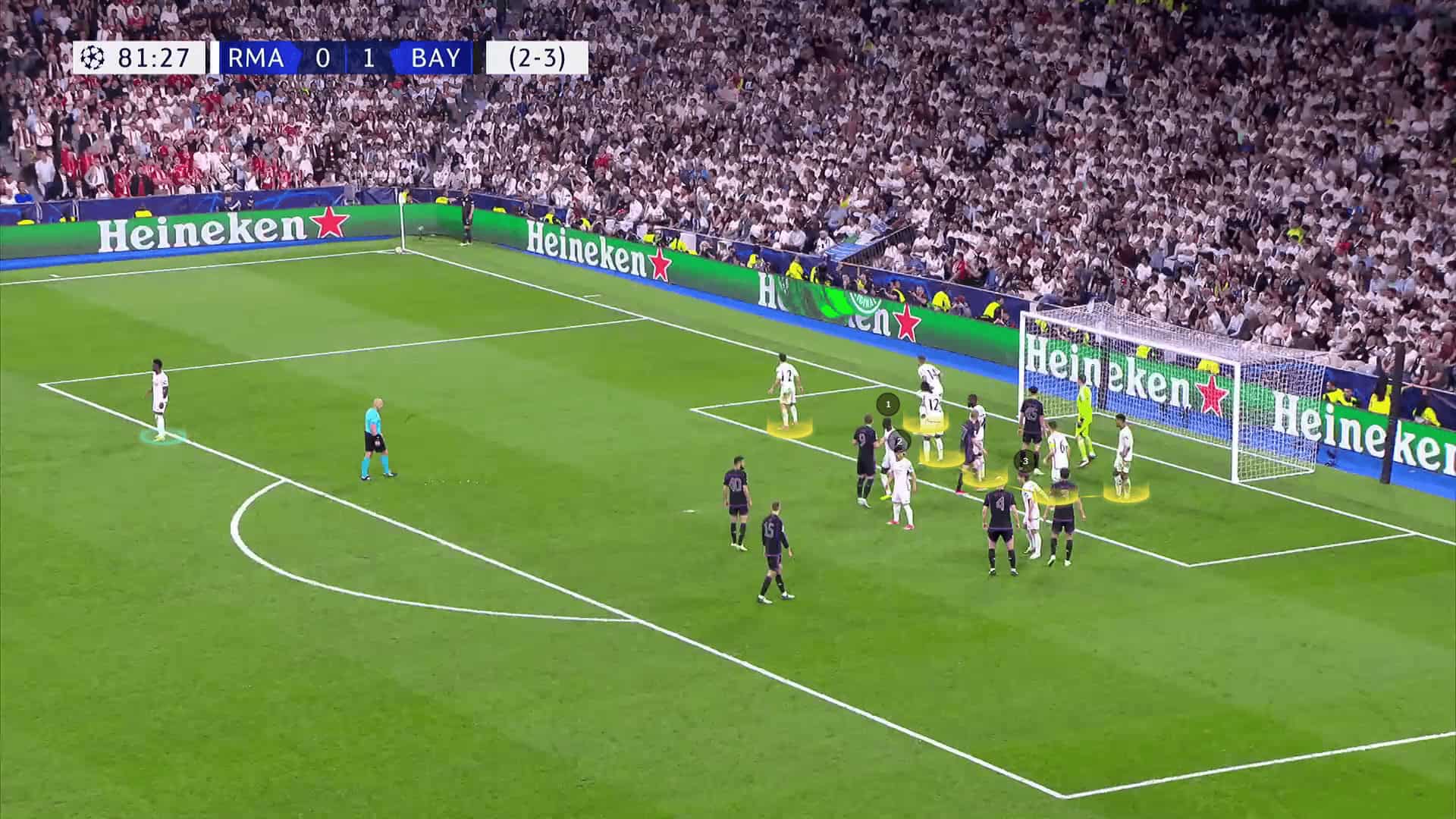
In the photo below, Bayern Munich exploits the shifting by asking the two yellow runners to run to the near post, with their two blockers motivating the zonal defenders to shift more toward the near post.
The two free attackers within the zonal line are asked to do two blocks.
The green one blocks the goalkeeper, preventing him from claiming the ball, while the orange one blocks Rüdiger, the central zonal defender, preventing him from getting back after shifting.
Note: You don’t have to put a player to block the goalkeeper clearly if you fear a foul, and you can do many other things just to distract him, delaying his reaction, like a run from his back to his front or doing traffic putting some players behind him between him and the targeted area making it difficult for him to claim the ball at the right time easily.
Ultimately, the third blocker, Luka Modrić, finds himself against three runners.
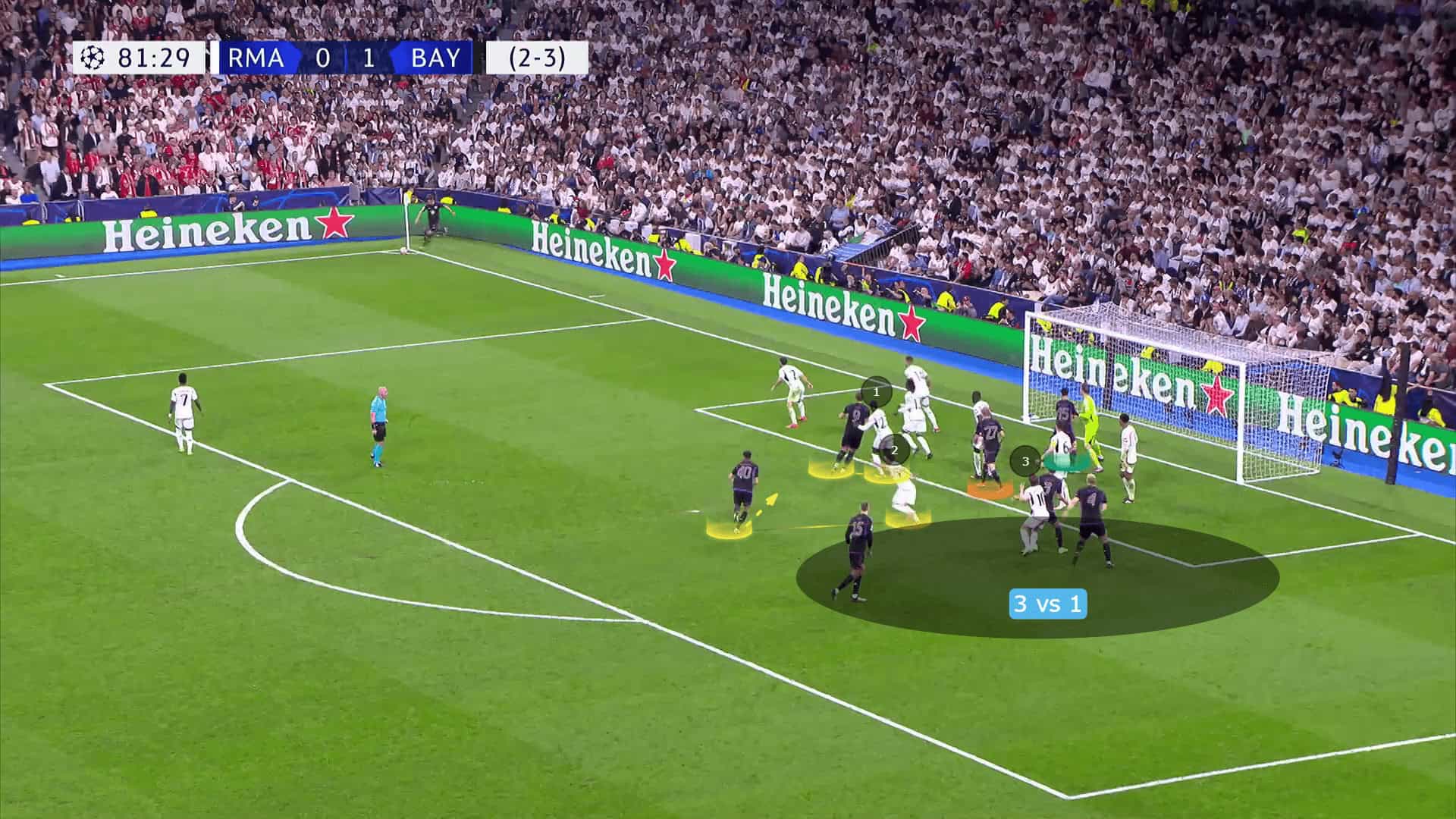
In the photo below, the shifting is clear, and you can see only two zonal defenders covering nearly two-thirds of the goalmouth.
Thus, you can see two zonal defenders and a weak man marker against three attackers, maybe four, with the attacker blocking the goalkeeper at the targeted area.
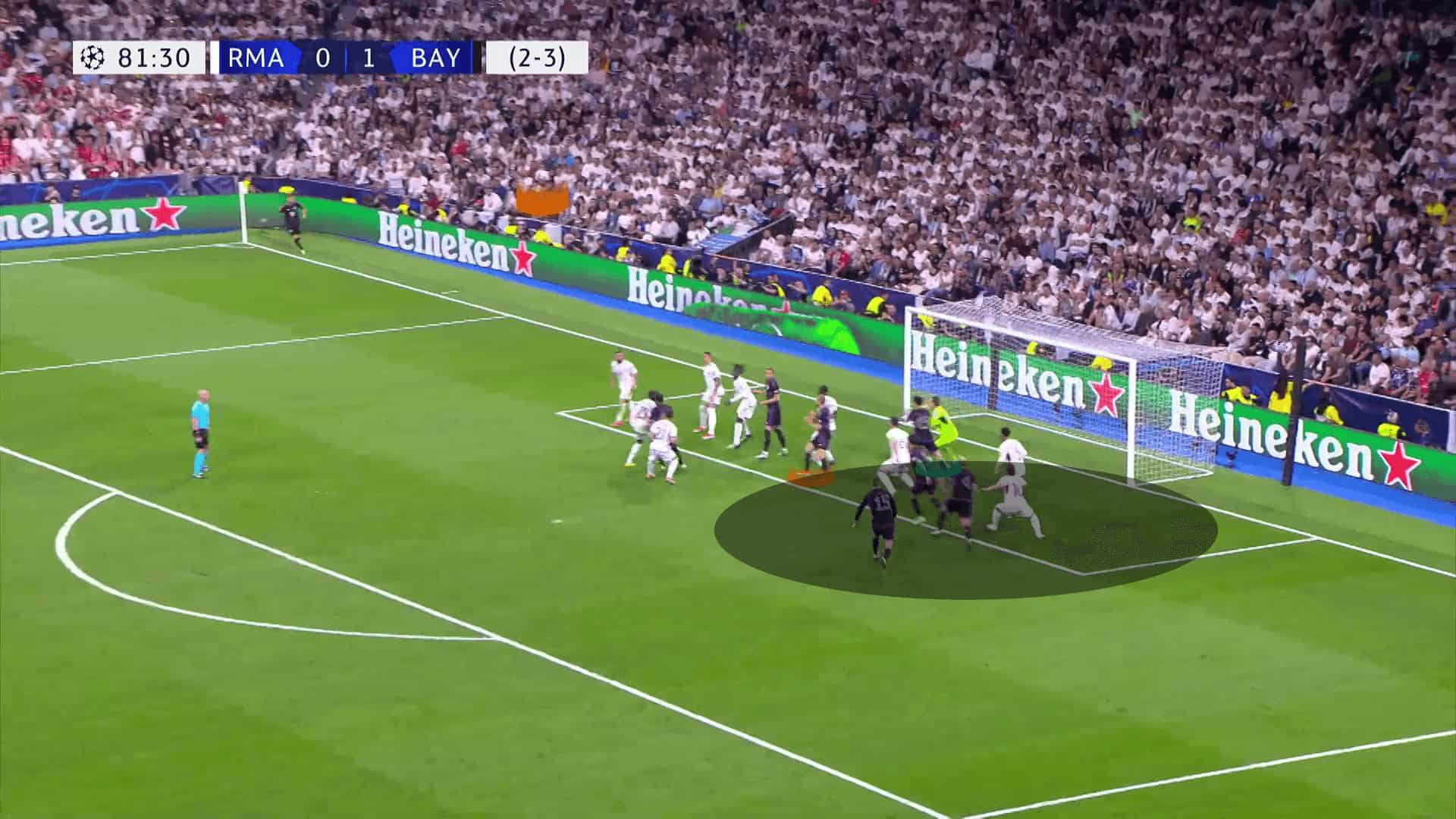
The ball may be under-hit, so it lands between the two last zonal defenders because of the large gap caused by that shifting.
Bayern Munich’s overloading in that area, as shown below, leads to a dangerous chance with the ball hitting the crossbar.
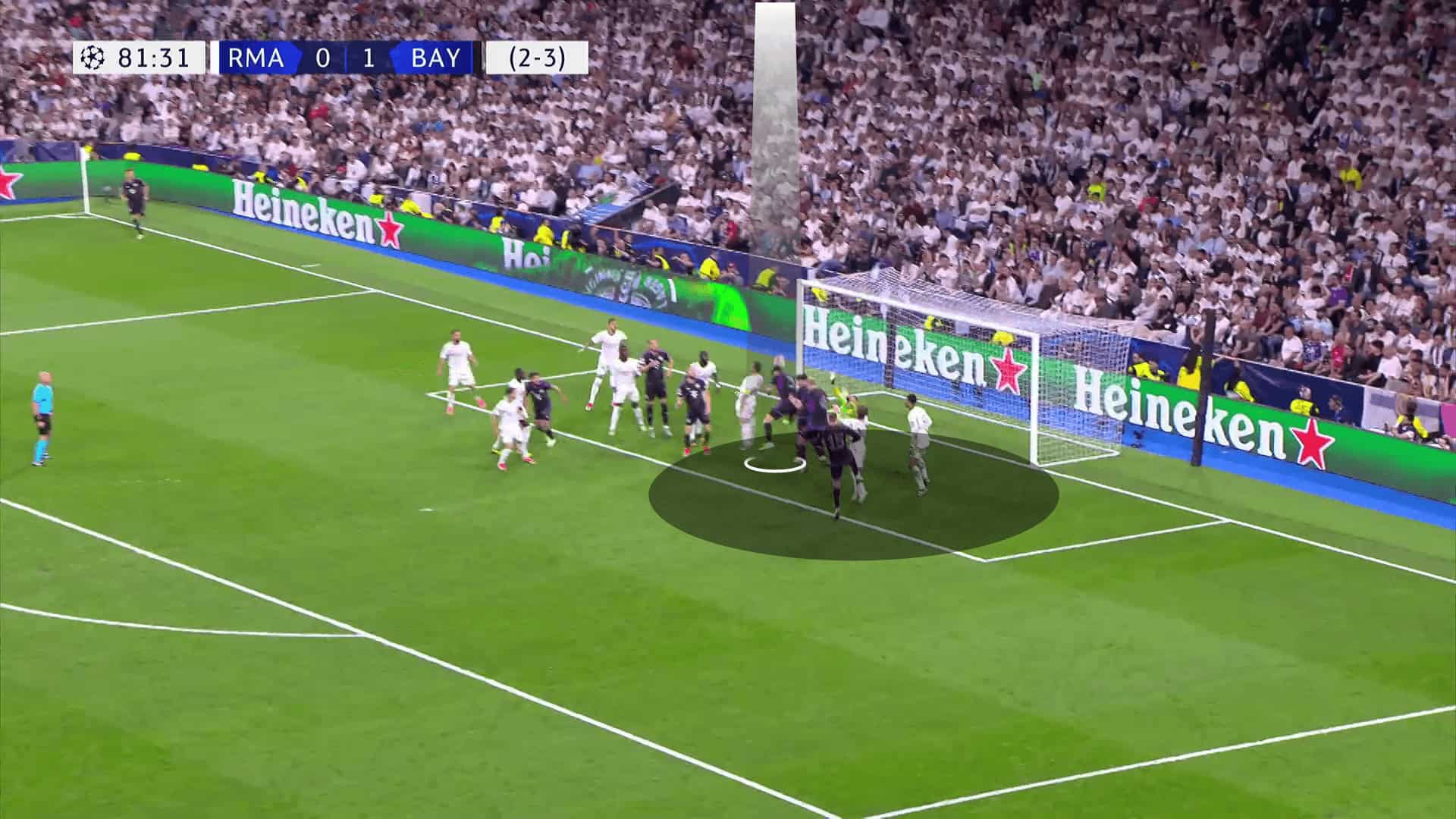
In this case, the other two points are evident: the blockers’ inadequate ability in physical and aerial duels and the starting position of the last zonal defender.
In the photo below, a similar idea is applied by asking the two free attackers behind the zonal line to block the goalkeeper and Nacho this time while the same two important attackers run toward the near post, leaving the two yellow-targeted players free.
One stands freely on the far edge of the six-yard while the other is supposed to be stopped by the third blocker, Bellingham, at this time.
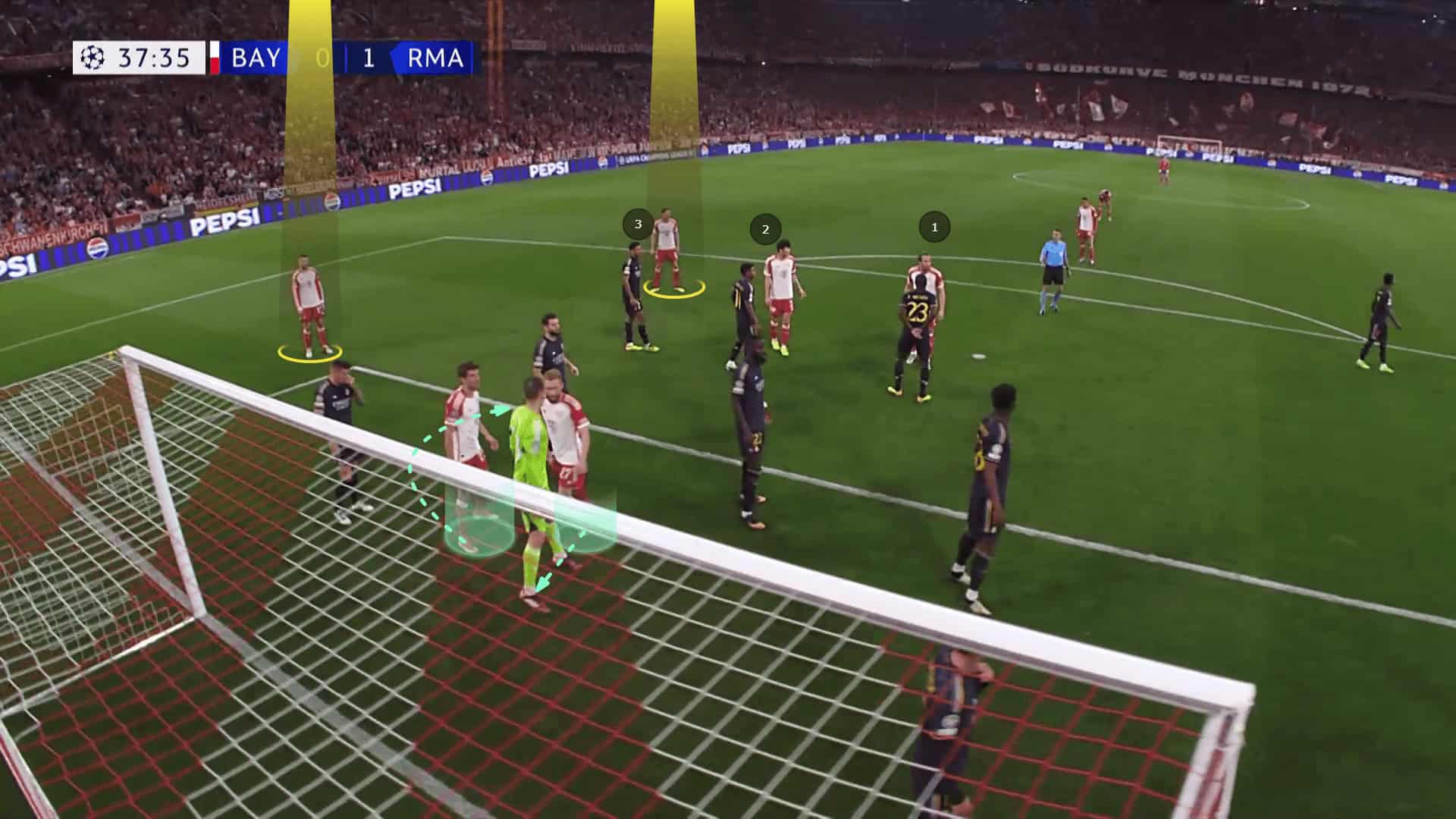
The two green blocks are clear in the photo below, but we want to clarify the other two factors we mentioned.
First of all, it seems that Bellingham, or all the blockers, isn’t a good marker blocker defensively on whom you can depend to keep sticking to or tracking the runners carefully and awake, so the attacker behind him is free.
This is supported by the two targeted players’ far starting positions beyond the whole defensive mean, which makes them on his blind side.
So he is in an orientation problem and can’t track the ball and the attackers behind him at the same time.
He chooses to track the ball, giving his back to them and raising his neck to track this floating cross, losing contact with them.
The second factor is the initial deep starting position of the last zonal defender, Toni Kross, which is a bit far from the targeted point.
This gives the attackers a chance to run before clashing with him, allowing them to run from jumping, which is considered a dynamic mismatch.
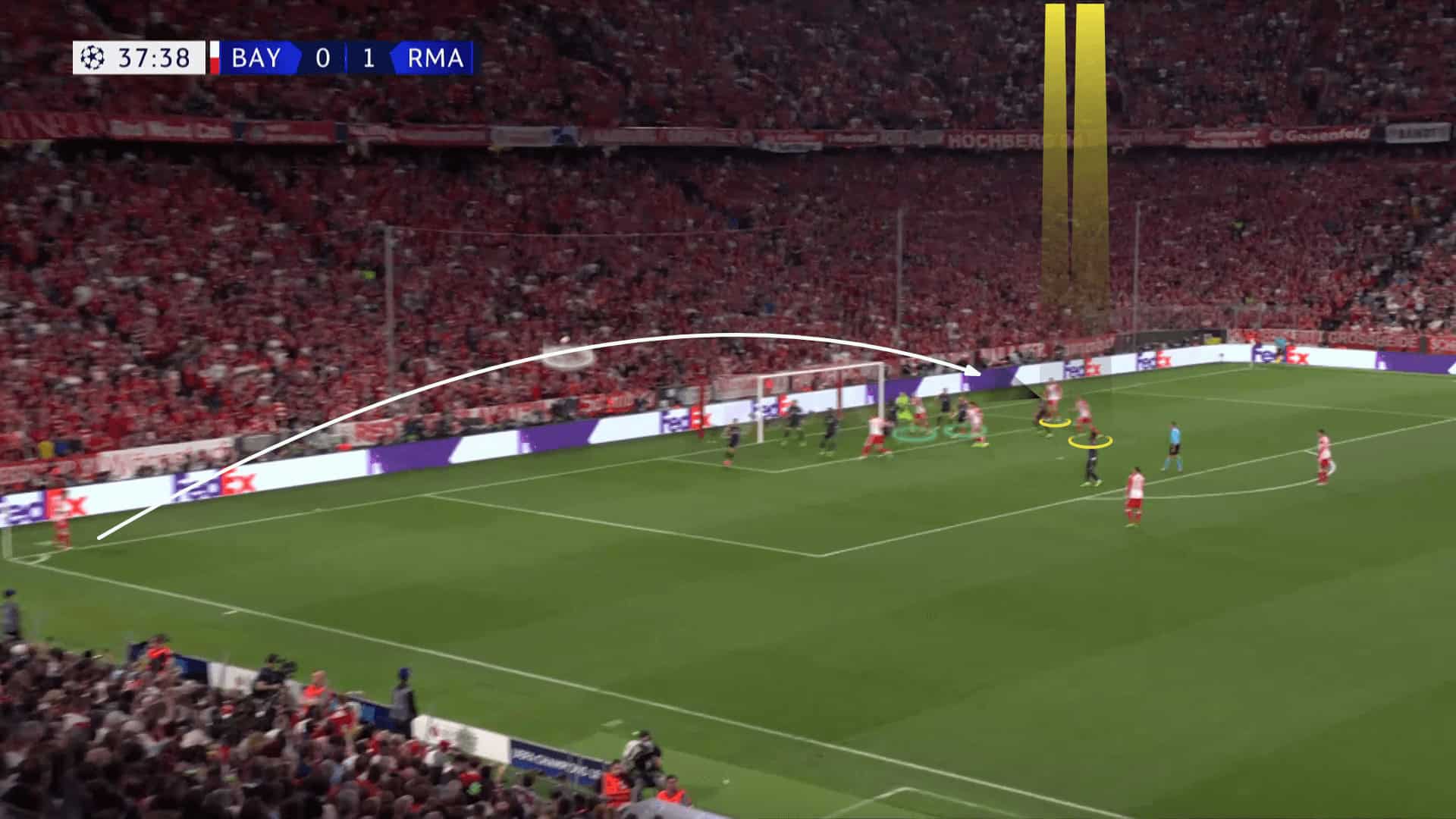
In the end, it leads to a chance, too, as shown below.
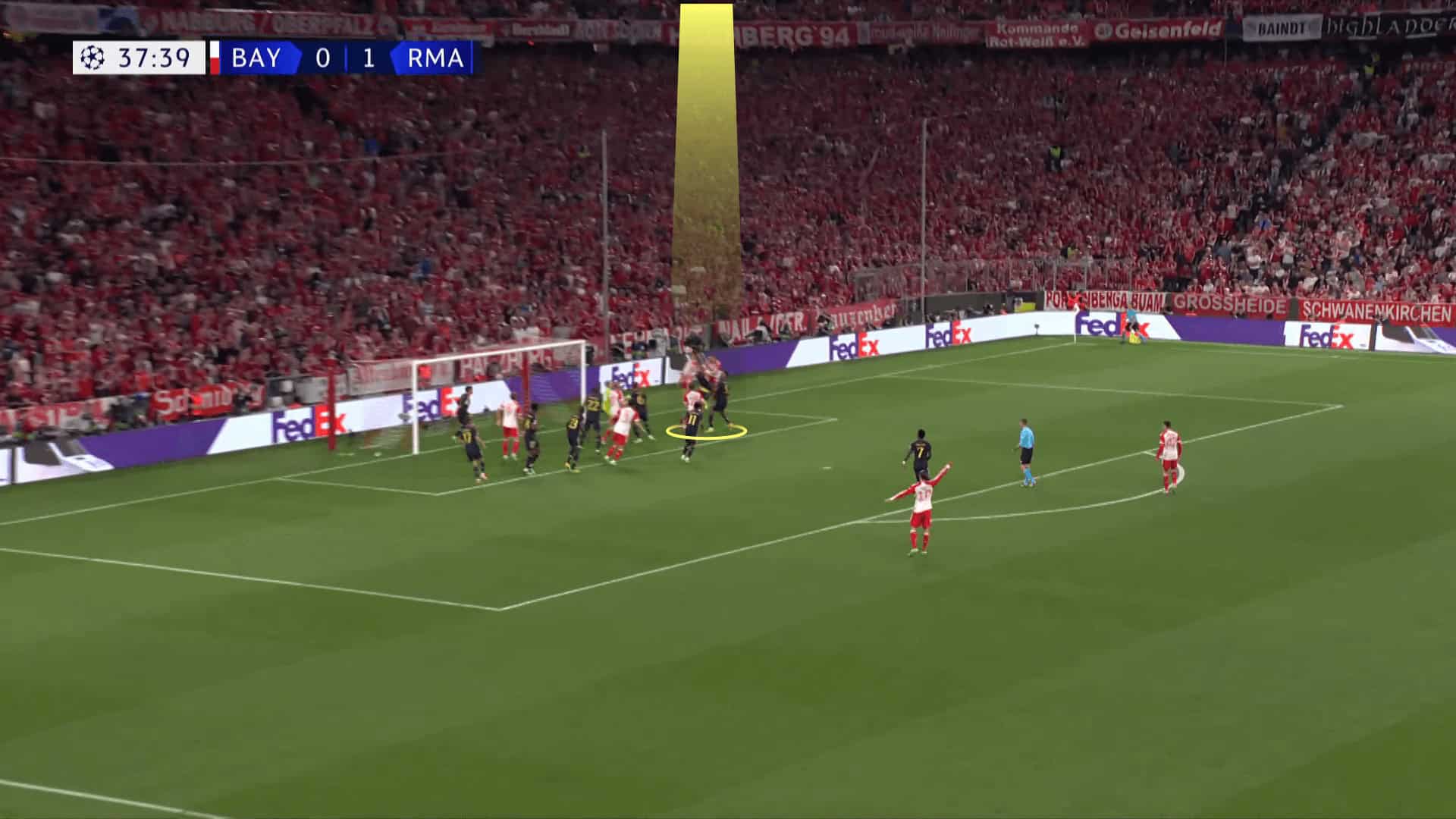
After that, they used the same main idea but differently, targeting a different area with a different cross-type, and it worked despite Real Madrid’s reaction to switching Rüdiger with Nacho.
They targeted an outer area using an out-swing cross, which targeted the blue-highlighted player, who starts at a far point on the edge of the box, thanks to his mate, who drags Vinicius Junior toward the short-pass area.
In general, this short option makes the blockers hesitate to stay in their positions, leaving the rebound area empty, as they did here, or ask one of them to stand there, which reduces the number of blockers to two.
Coming back to our routine, the two white attackers block the arrowed two zonal defenders, as shown below.
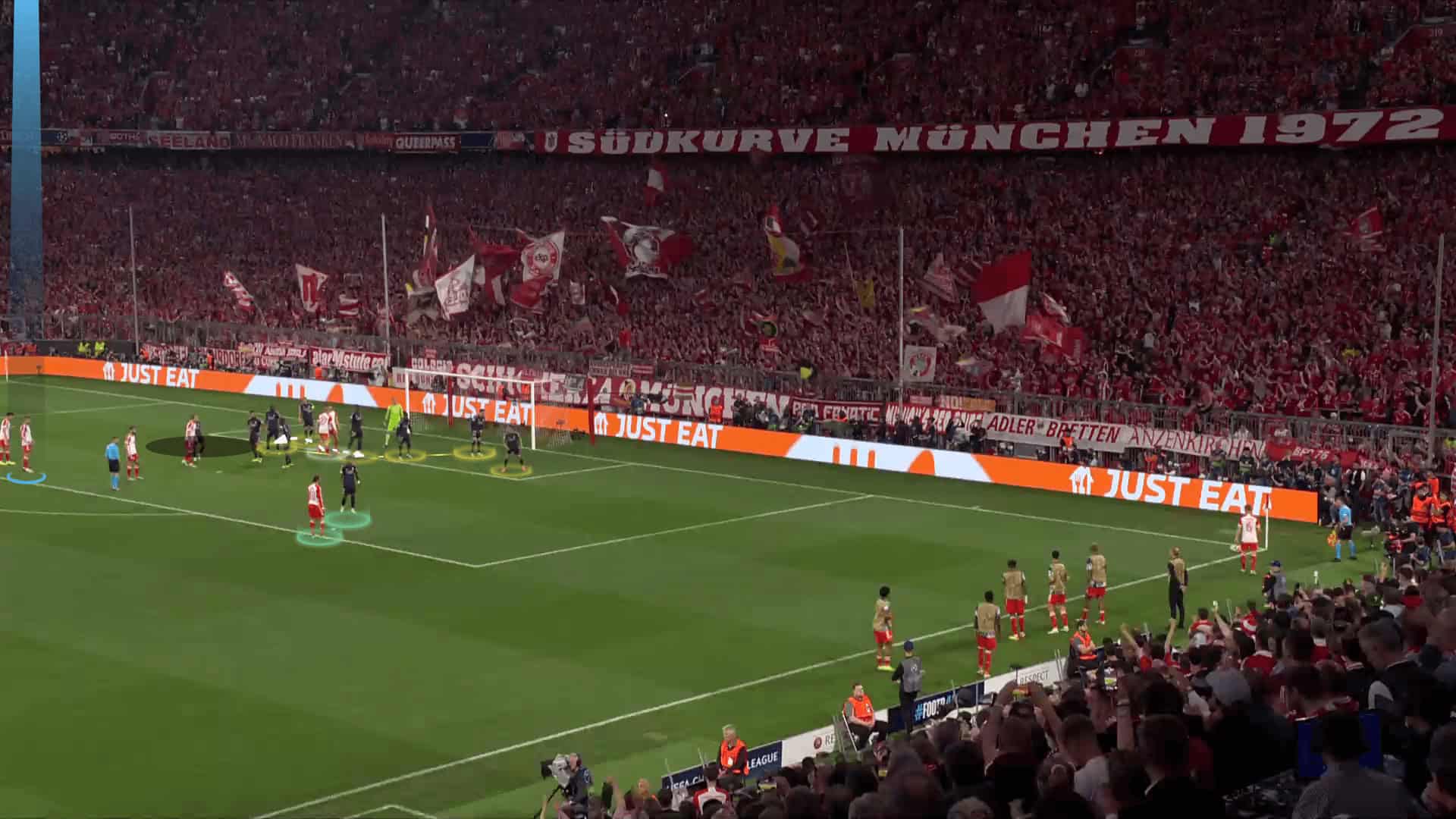
The routine begins with the two blocks, the two usual decoy runs to the near post and this time a player moves first to the far post to drag the third marker who stands on the targeted point to free it for the targeted player who starts to move late without anyone noticing him.
Note: This time, the third marker decides to give his back to the ball, losing contact with it for tracking the attacker who isn’t the targeted one
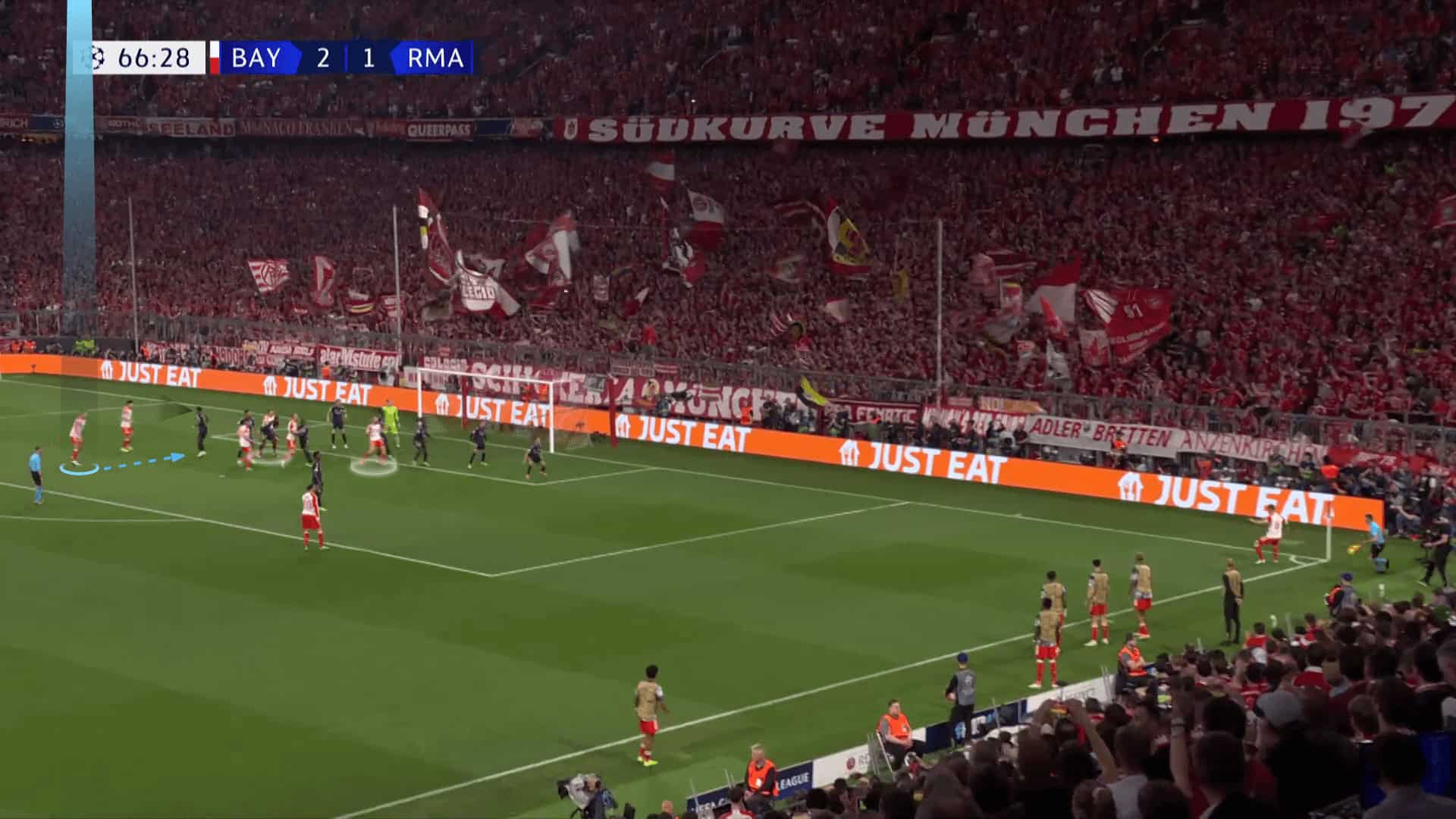
It leads to a dangerous chance, too.
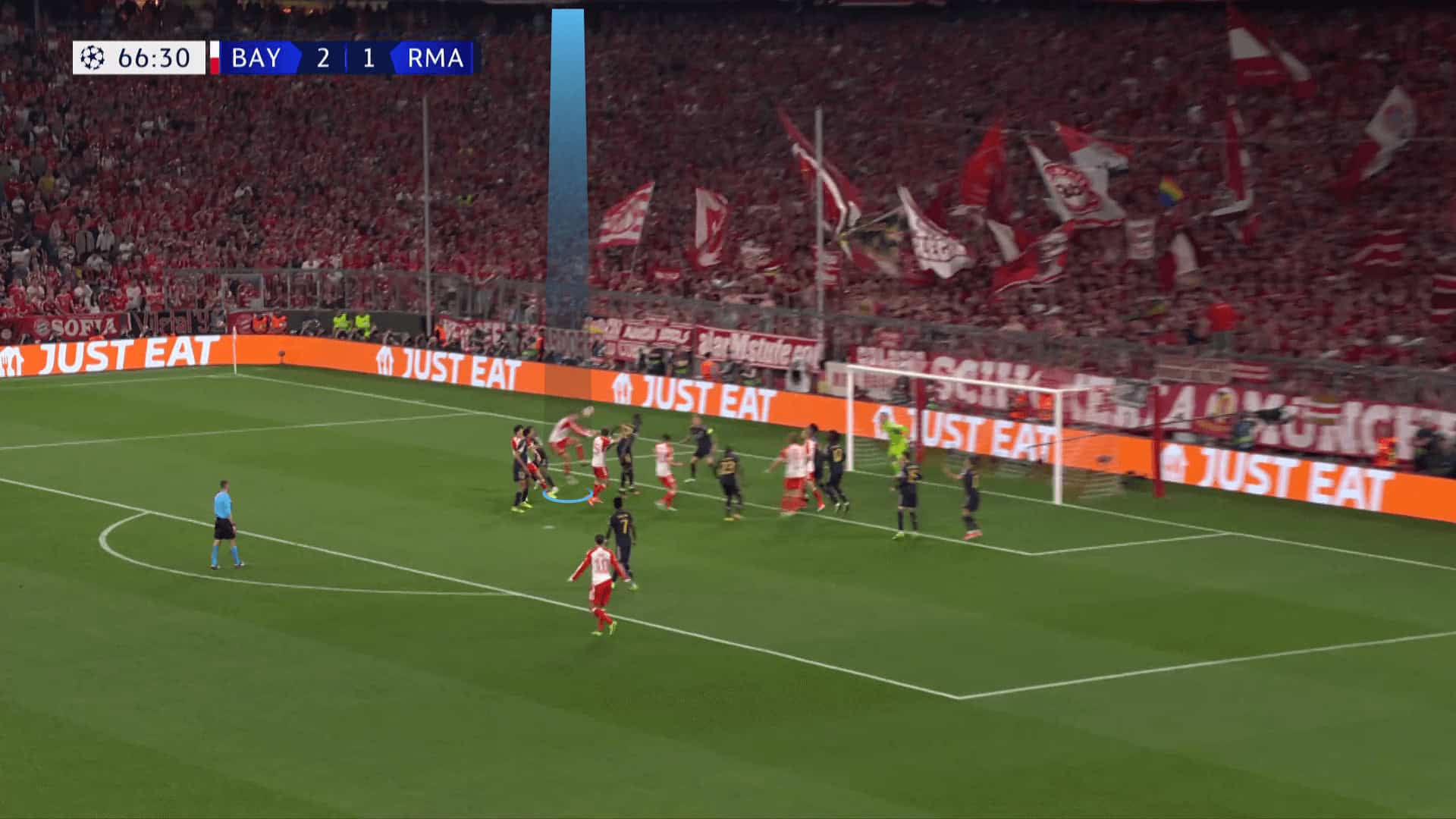
Man Markers Preferring Counterattacks
There is a problem related to this problem: Players like Kylian Mbappé, Rodrygo, or Vinicius Junior are often used as blockers because they prefer not to stick to the attacker for a long time, coveting counterattacks, so they may leave their attackers earlier running forward for the counter.
In the photo below, with Thibaut Courtois guarding the goal, the two yellow attackers will go to the usual far-post area, one in front of Bellingham and the other behind him.
One is free because of his starting position near the zonal line, while the other is free because the blockers wait horizontally while the three attackers go to the far-post side.
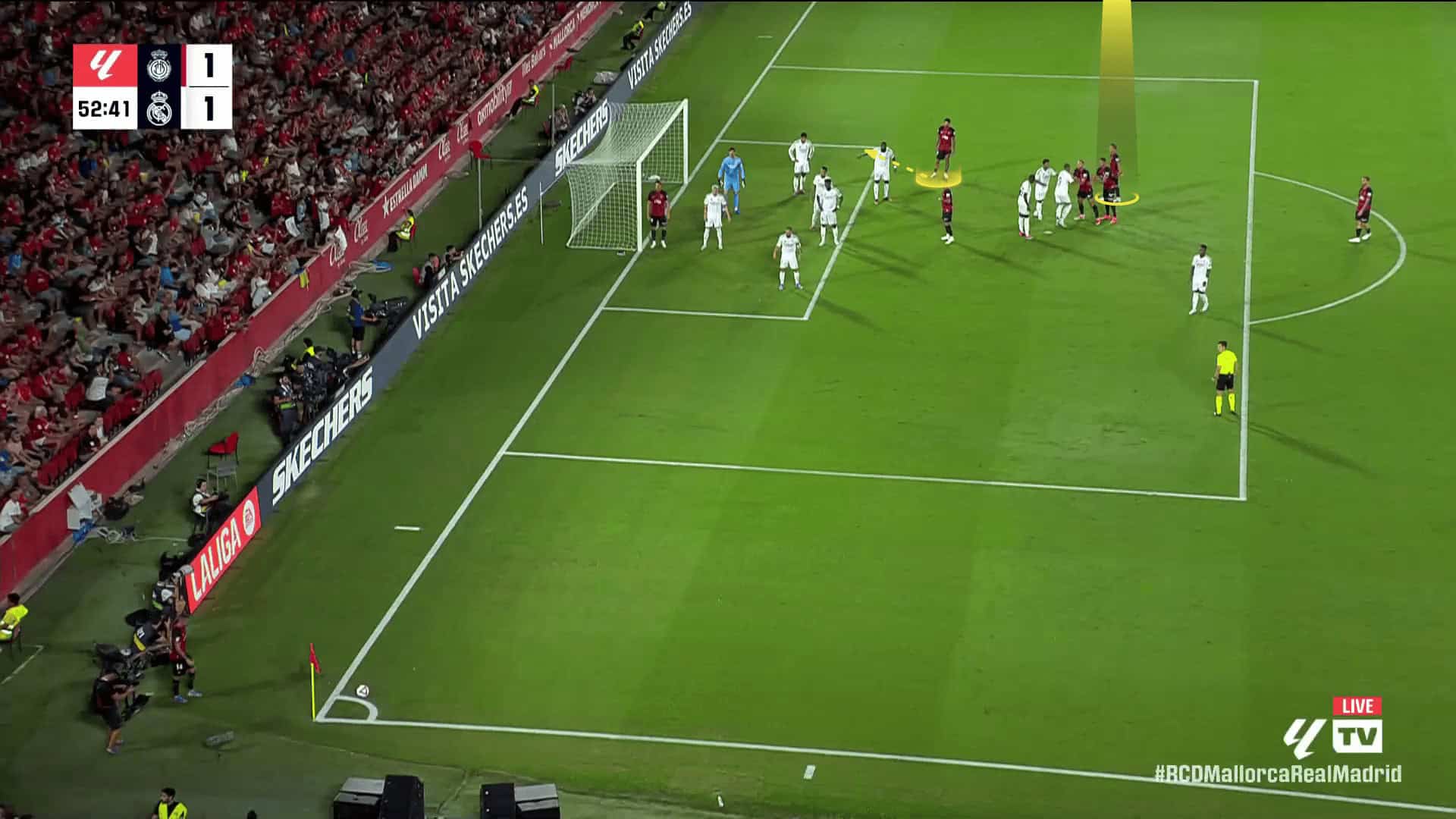
All of the previous things are normal, but we want you to focus here on the two blue blockers, Rodrygo and Mbappé, who are blocking two attackers, as shown below.
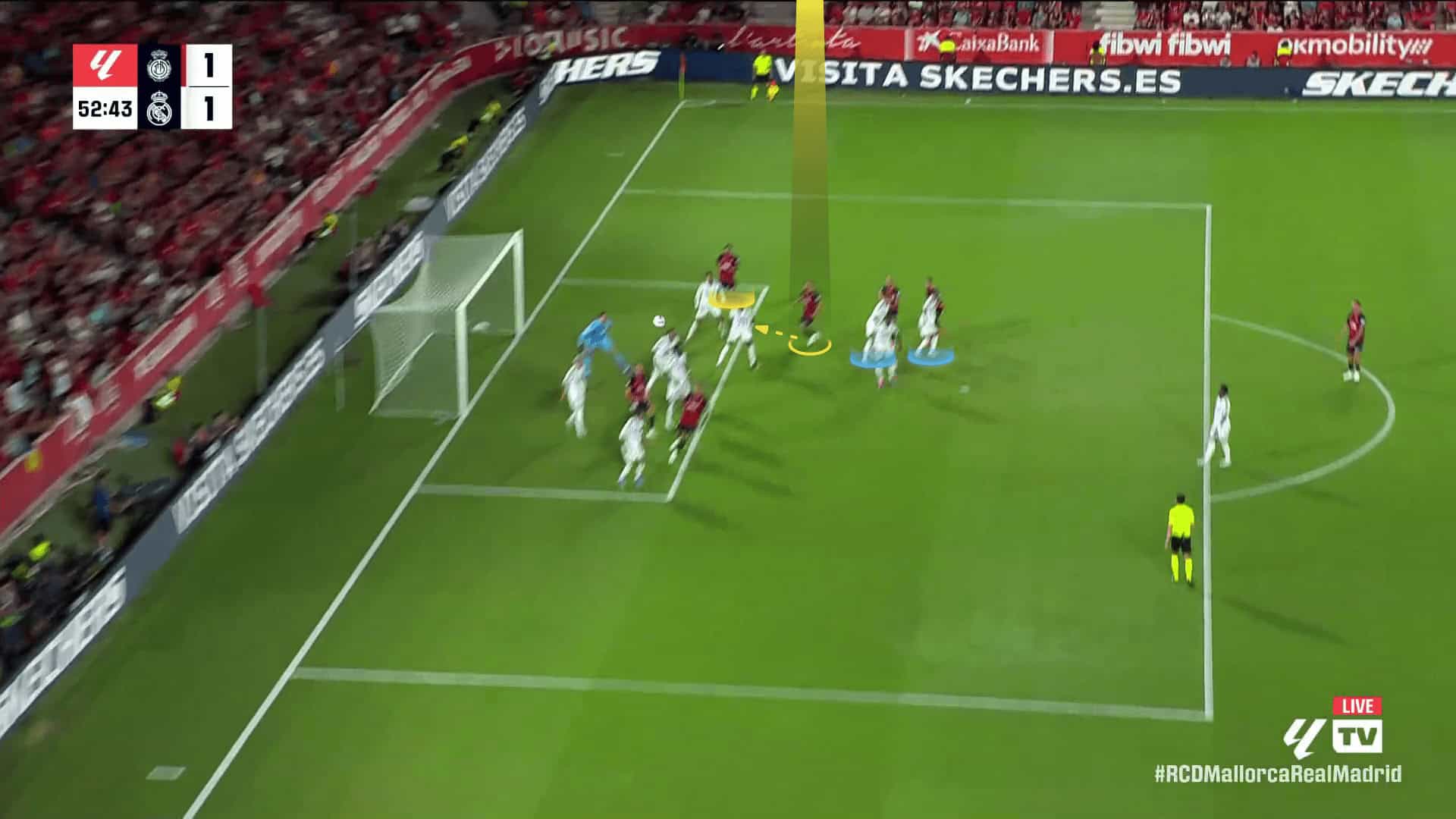
They start to leave them free early in such a dangerous situation, while Bellingham takes time to reach that area because of his starting position, which we discussed above.
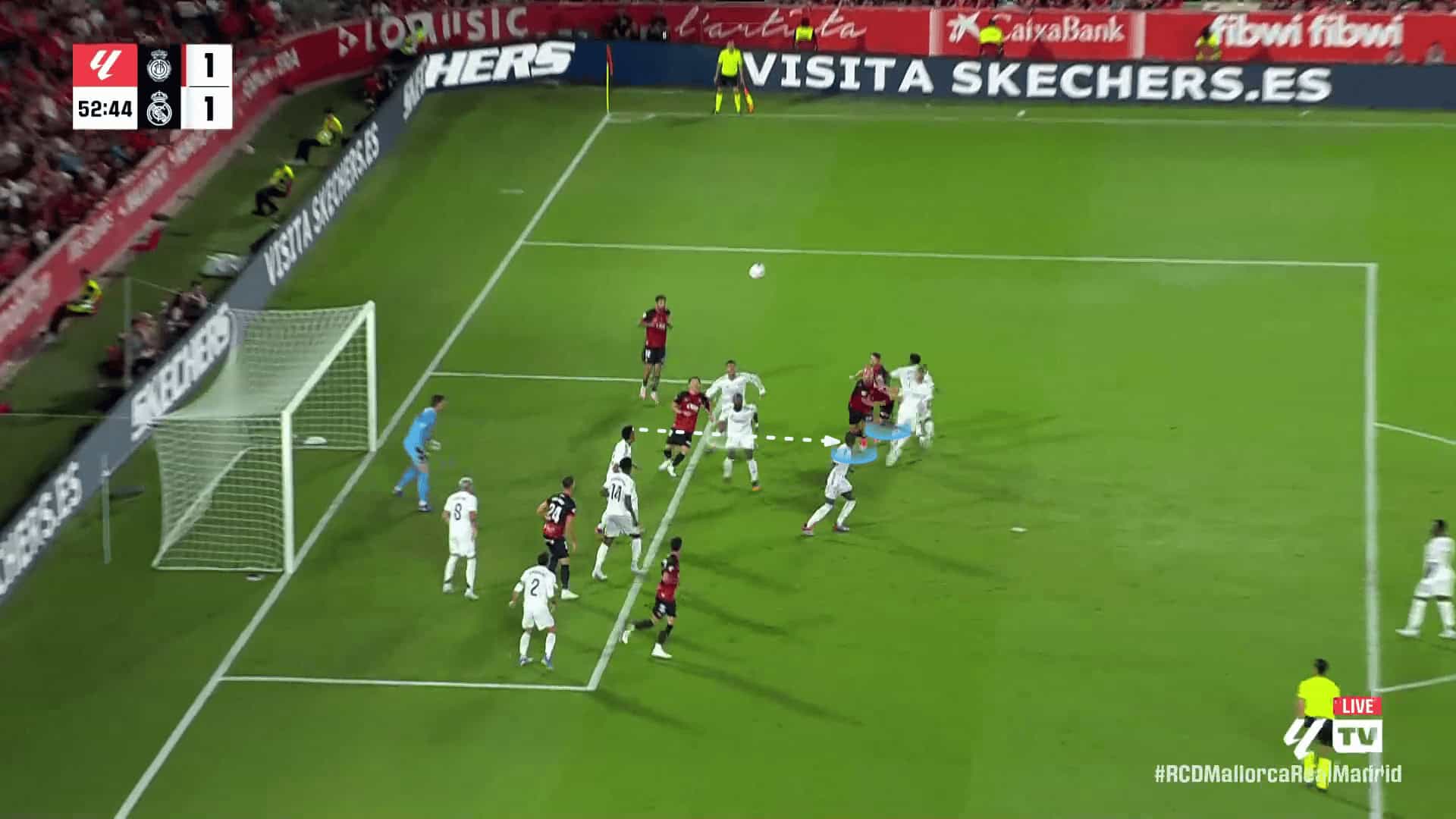
One gets the ball, scoring the first goal in Real Madrid’s net this season, while Mbappé is stepping forward for the counterattack.
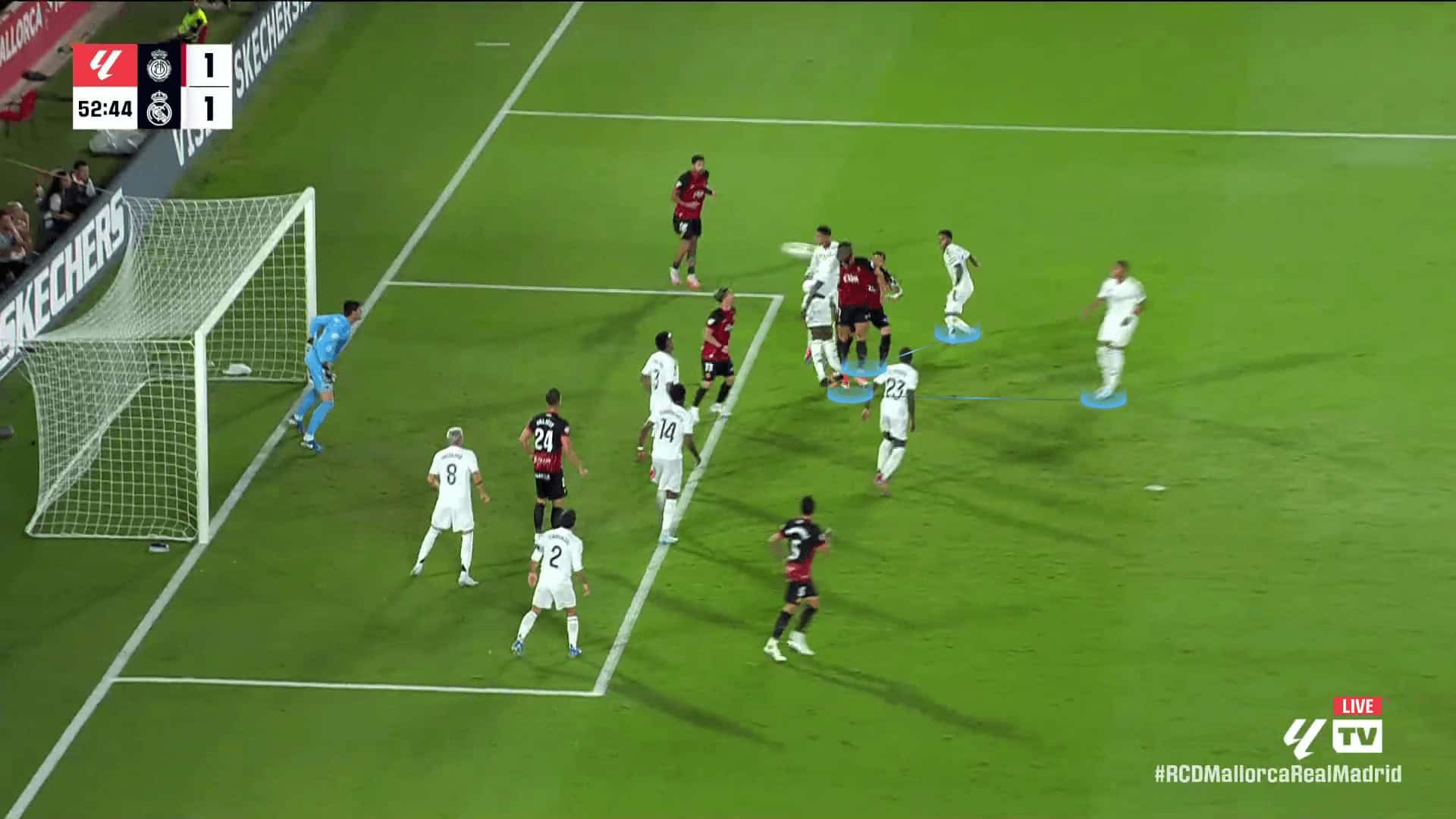
Last season, Barcelona used the same idea in a similar, easy way, using a floated cross to target Andreas Christensen, who started free at the far edge of the six-yard box.
At the same time, a player distracted the goalkeeper’s attention, and important players faked runs to the near post, causing that shifting.
They also used the short option to drag Vinícius, making one of the blockers worried about the edge of the box, as shown below.
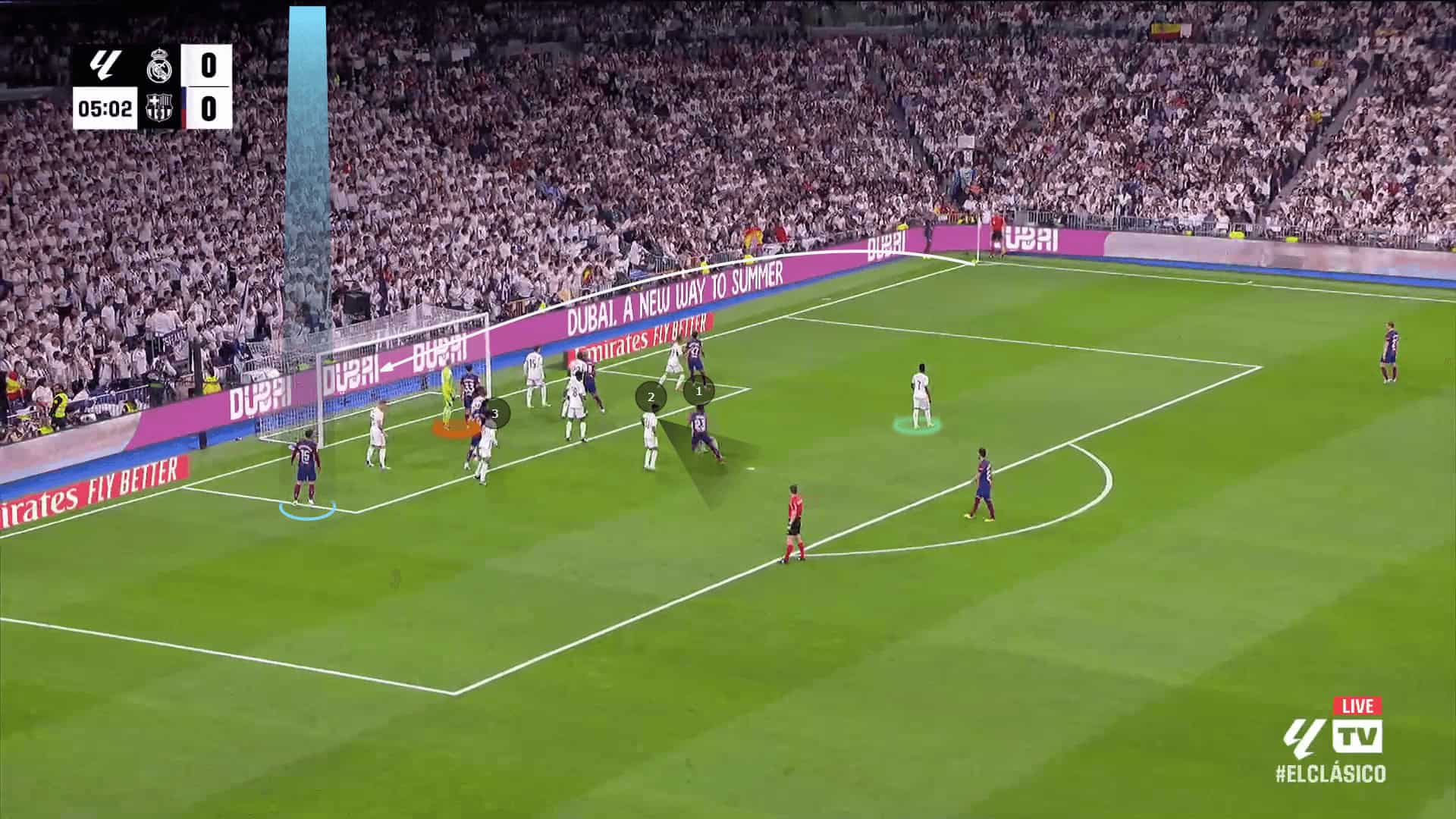
The plan worked, so Christensen jumped from the blind side of Kross, and the goalkeeper didn’t have time to retrieve that floated cross after this distraction, as in the two photos below.
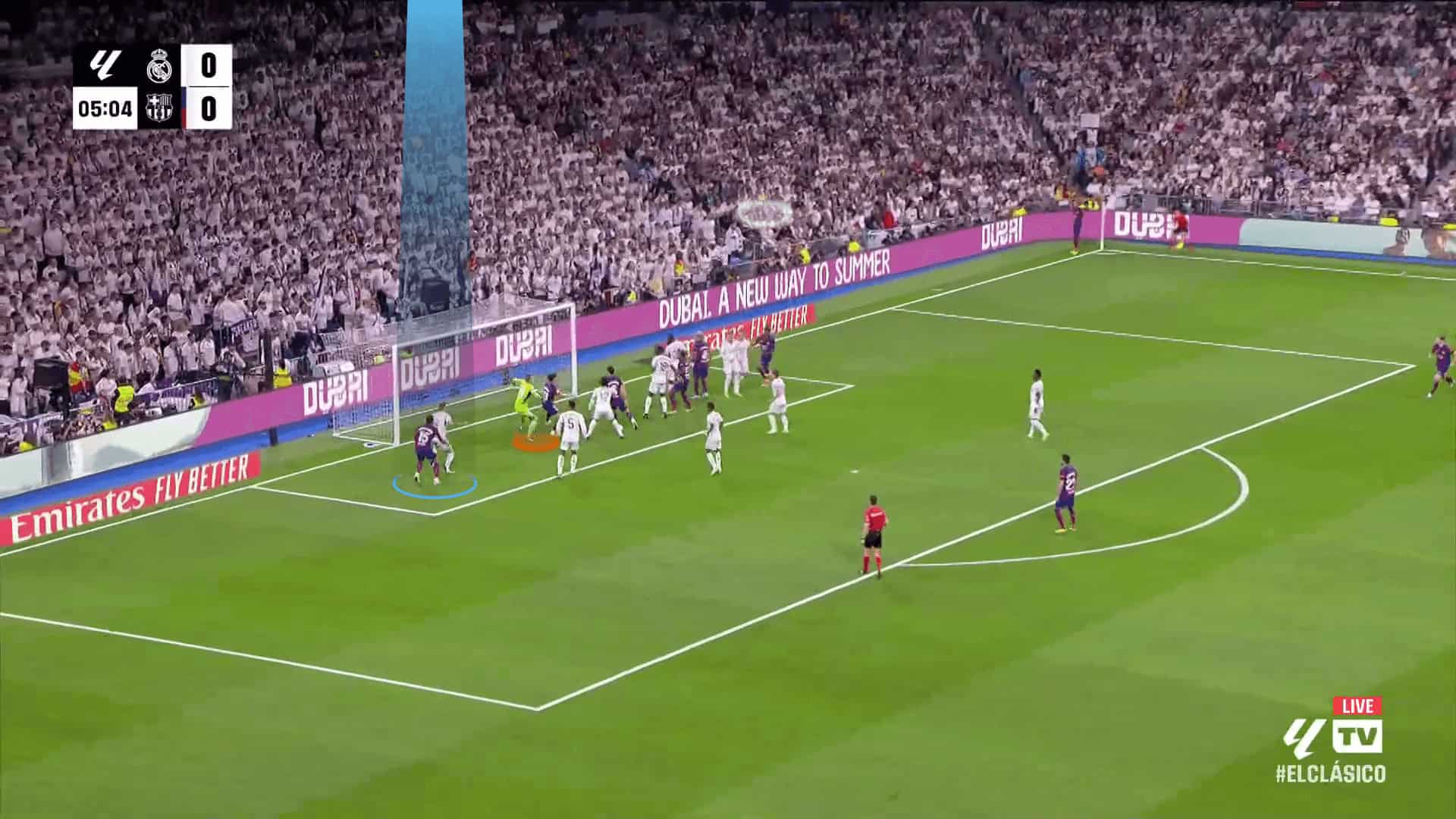
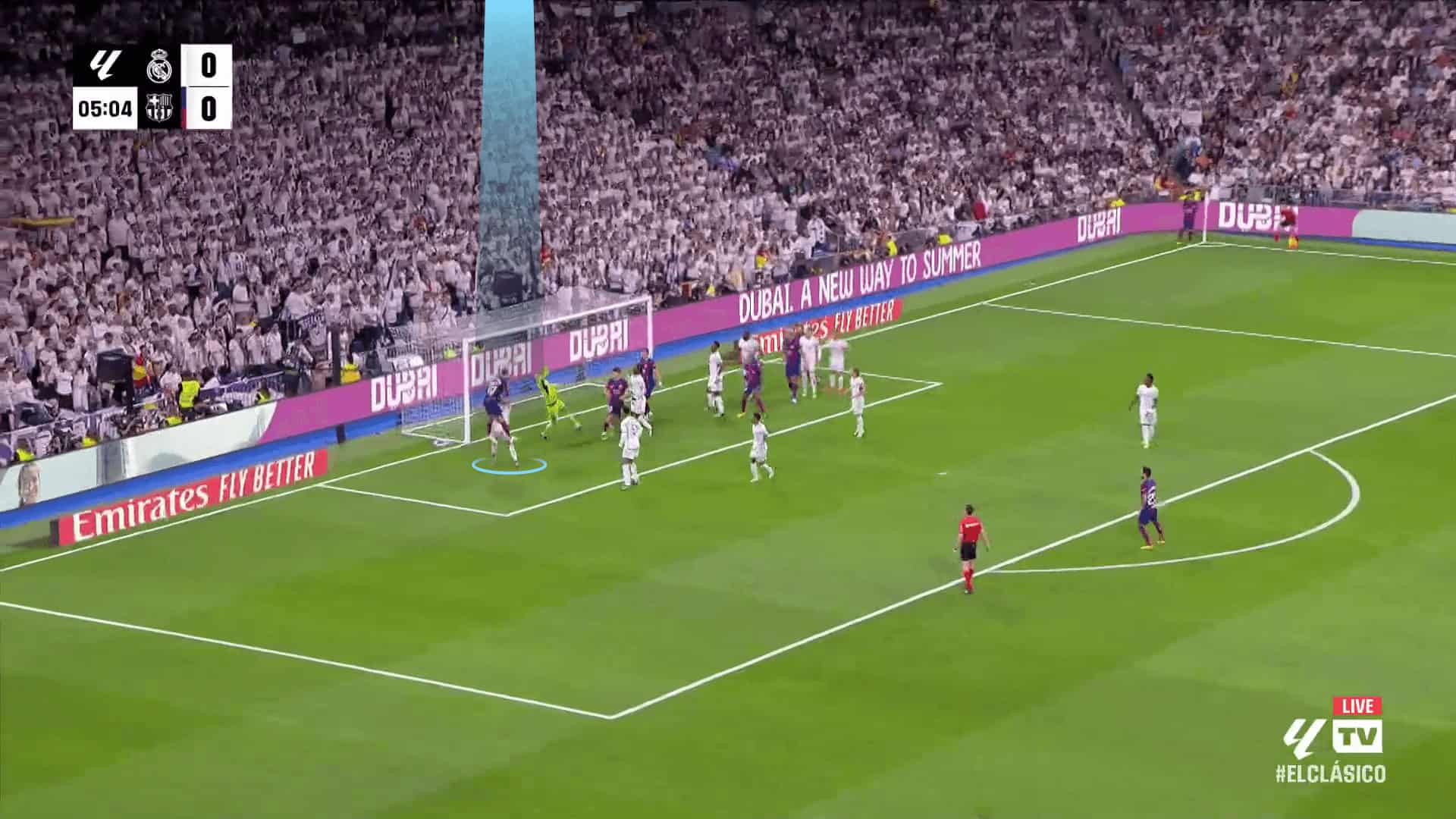
Dani Carvajal’s Replacement
We want to highlight a simple issue when Carvajal isn’t playing: they replace him with Lucas Vázquez, who can’t measure the ball in the air and may rush, leaving the landing area behind him empty because of any fake run, as in the two photos below.
We also want to suggest that the zonal defender on the near post always goes to cover this gap.
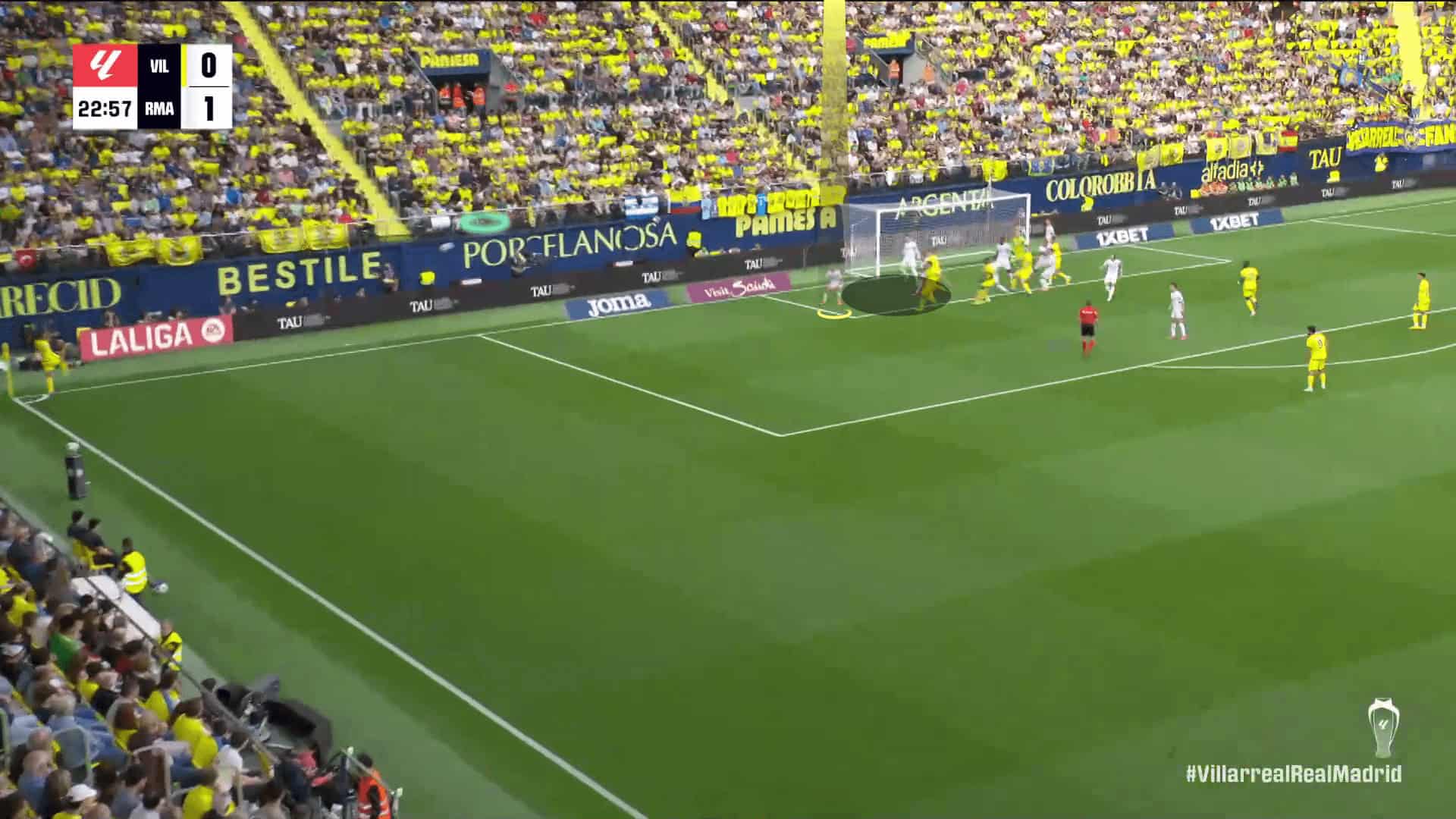
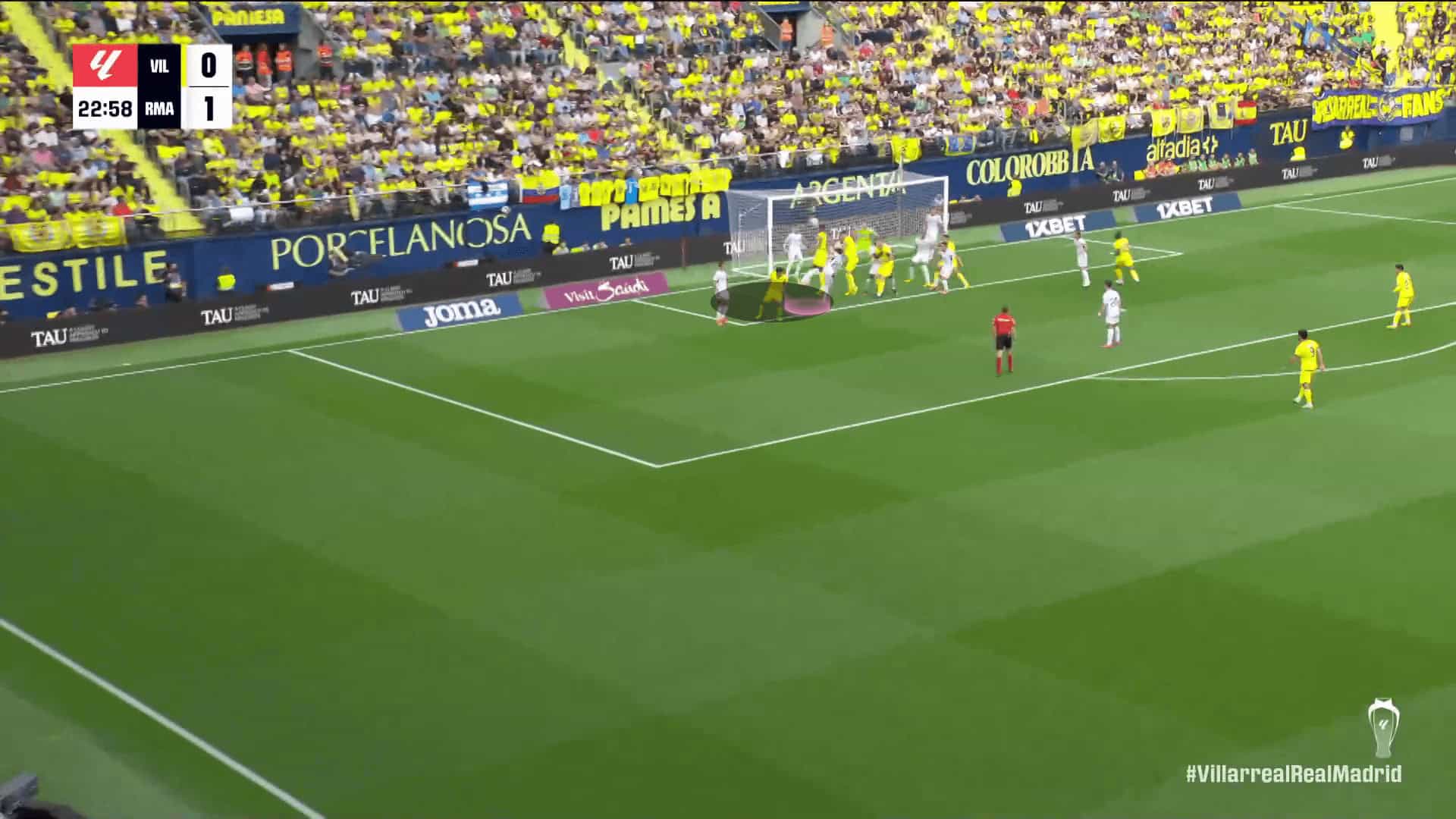
Suggestion
To address this gap, we suggest that Real Madrid avoid overcommitting the last zonal defender in that deep position as Liverpool did with Trent Alexander-Arnold.
Instead, sometimes, he should advance a step when attackers do not occupy the area.
This allows him to meet the runners early and reduce their speed before they make their run, especially if the opponent is known for this.
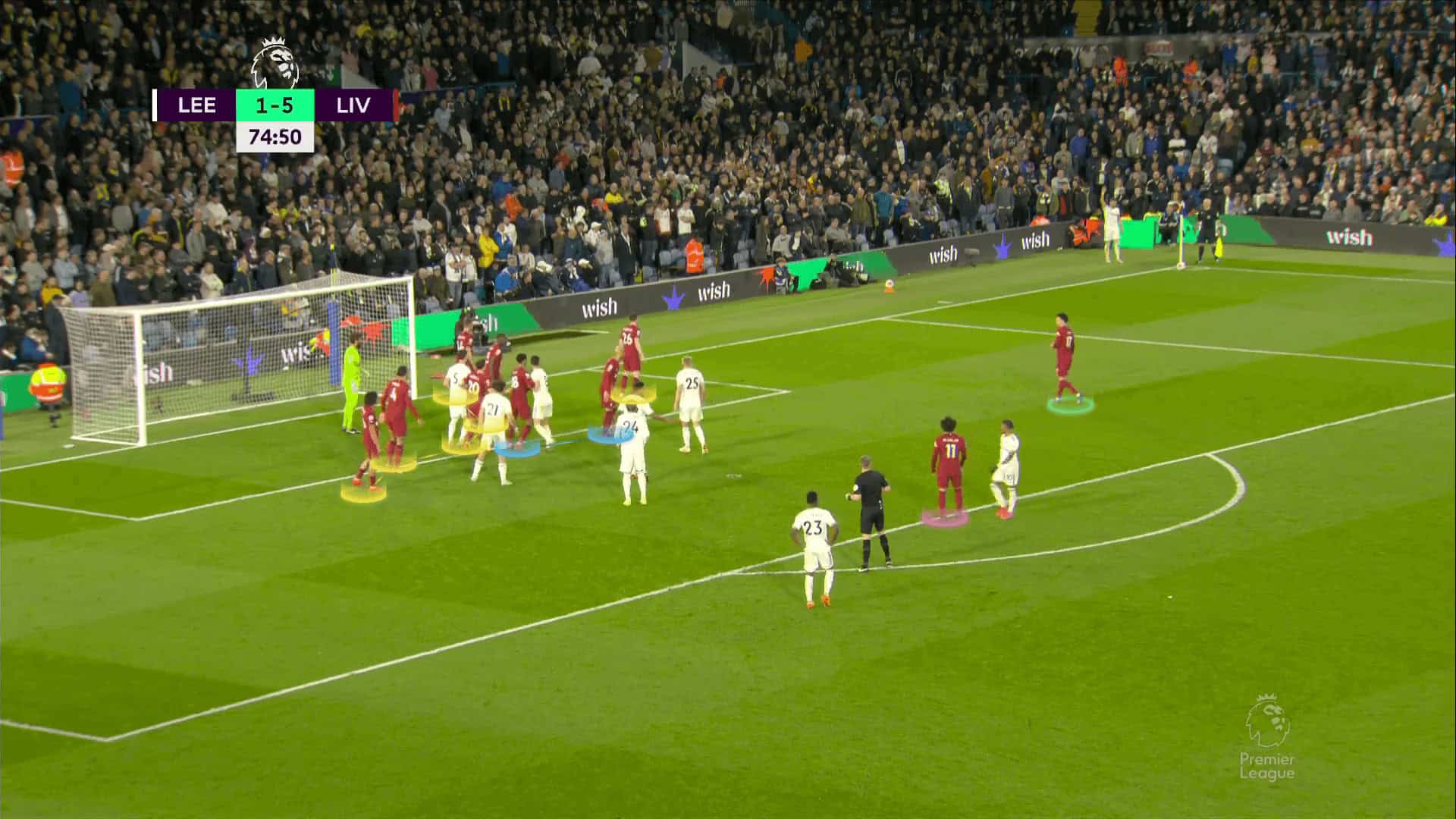
We also suggest always, not only sometimes, putting the best defender before the last zonal one to help him and can’t go toward the near post, causing shifting because six zonal defenders are enough to cover the goalmouth without shifting, as Liverpool did in Jürgen Klopp’s era.
Liverpool put Virgil van Dijk as the fifth zonal defender with the intention of trying to chase the ball before getting to Arnold with his incredible power and anticipating the cross trajectory, as shown in the first three photos below.
Having the super Alisson Becker, they have an additional safety factor to claim the ball before reaching the far post, as shown in the fourth photo below.
However, we may skip this point because Thibaut Courtois always wants to go and claim the ball, but he is blocked, the targeted area is too far, or the cross is too floated, as we have mentioned.
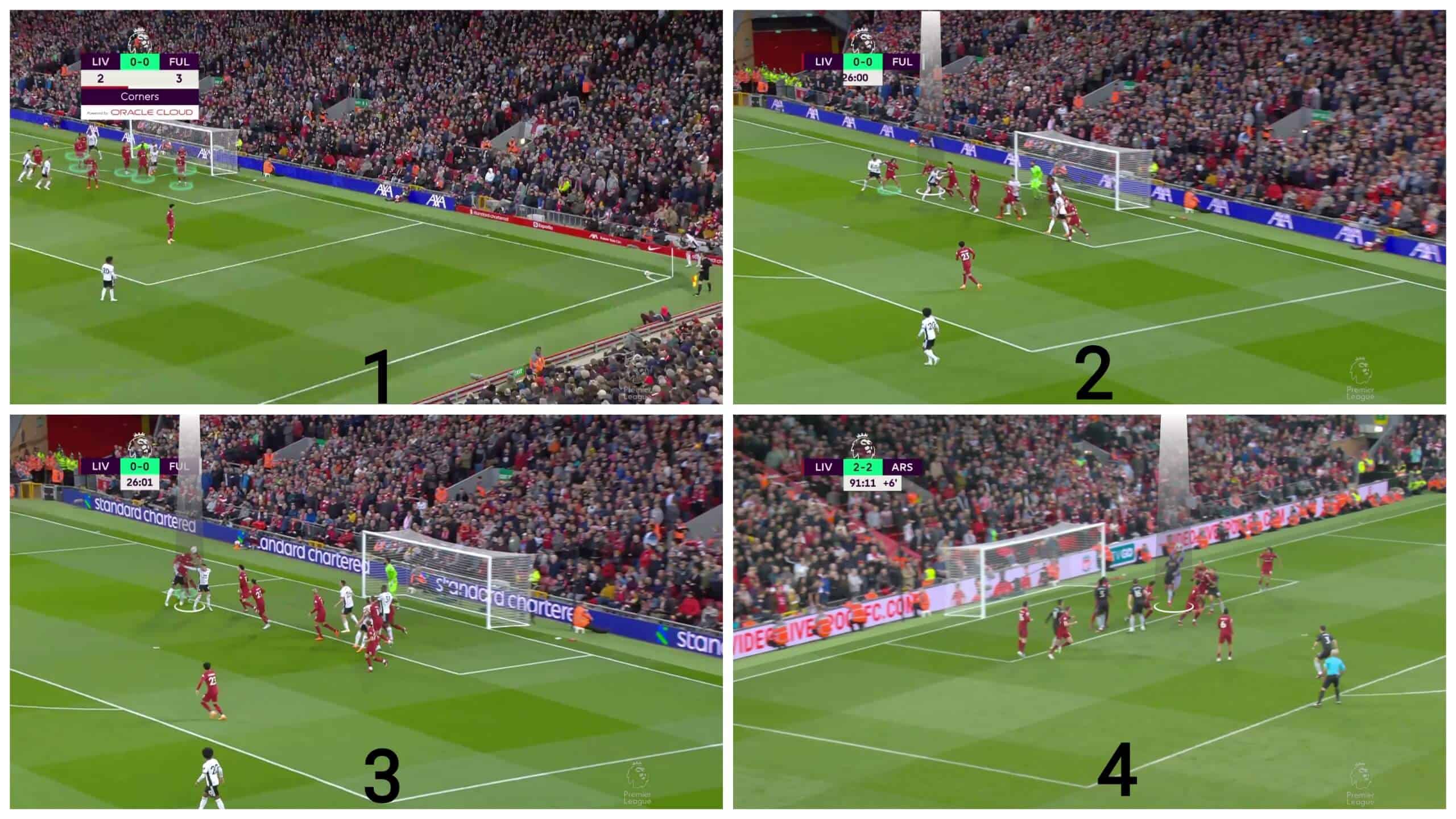
Conclusion
In this Real Madrid tactics analysis, we have shown potential weaknesses in Real Madrid’s scheme while defending corners that have yet to be exploited adequately. We think these weaknesses are so clear, simple, and easy that not many teams noticed them.
In this set-piece analysis, we have introduced our reasons for these claims and offered some suggestions. Let’s wait and see Real Madrid and the opponents’ reactions during the season.

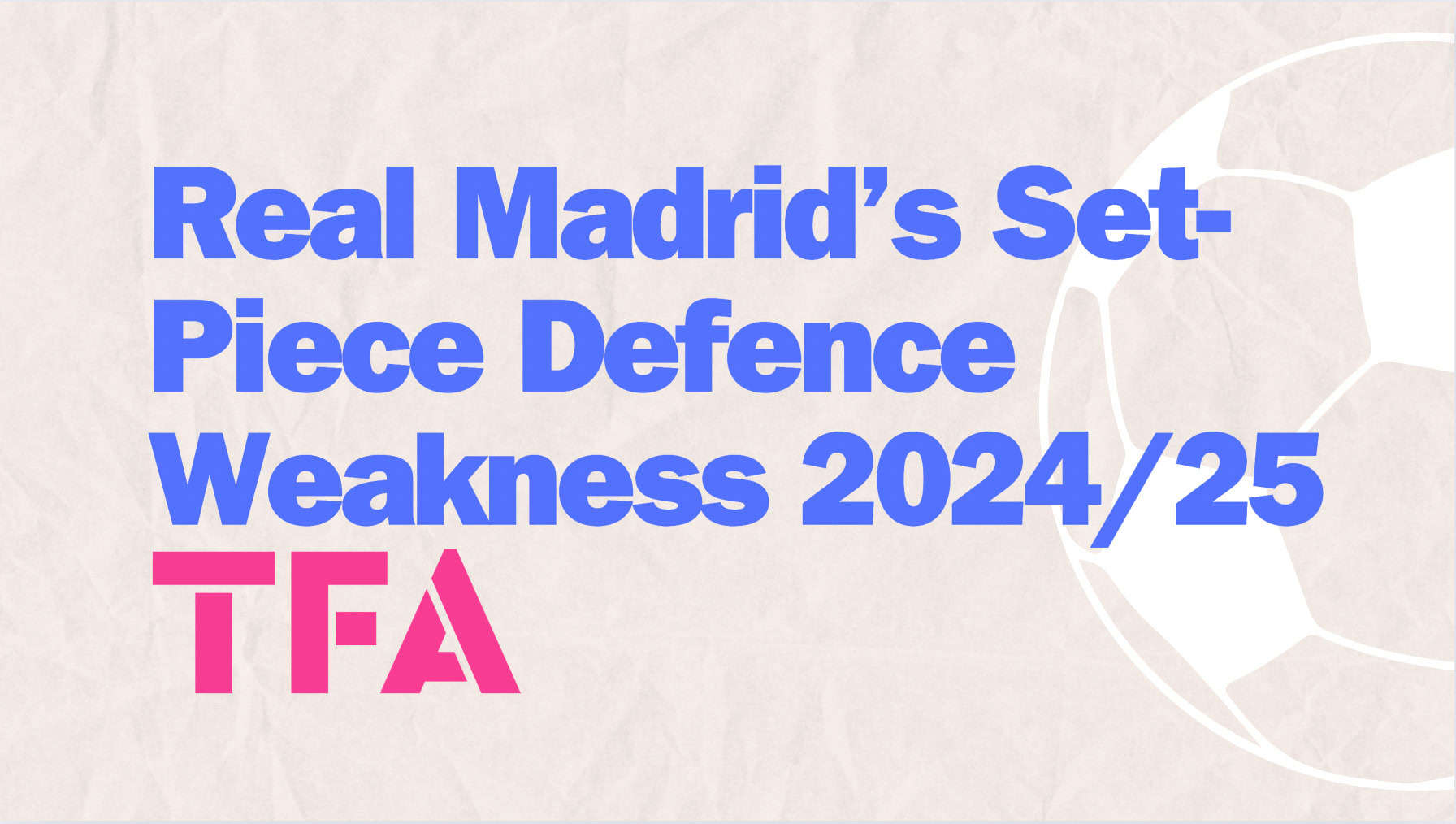




Comments